Variant 1: Battlecruiser Squadrons 1915
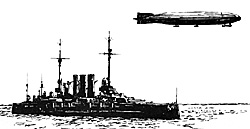 The first variant you might try if you haven't the inclination to play the full length version of the game. It represents an action that took place in the year 1915.
The first variant you might try if you haven't the inclination to play the full length version of the game. It represents an action that took place in the year 1915.
There is no Fleet Search or Strategic movement. The game begins as the forward elements of the British and German Battlecruiser Squadrons make visual contact. Their positions are as shown on the chart [below]; strengths, as on the Hit Record. Use counters from the JUTLAND game as well as those provided. Follow existing tactical rules.
Each player recieves, for sinking a capital ship, a number of points equivalent to the broadside factor printed on that ship's counter. Whoever has the greater number of points at game's end is the victor.
Cruiser Squadrons must deploy at points 'A' and 'B', thus establishing visual contact. If visual contact is lost such that no opposing ships are in visual contact, game ends.
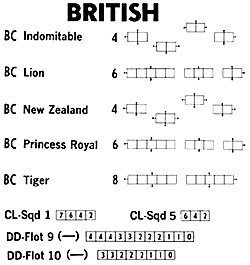 |
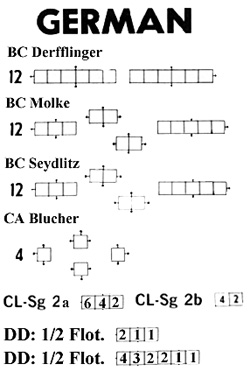 |
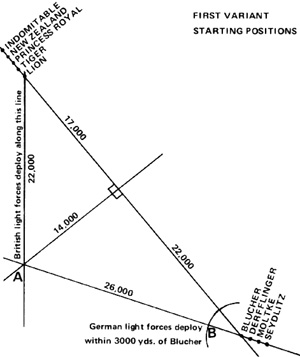 | |
Variant 2: Strategic Movement
A second variant has to do with strategic movement.
One reason the British Battlecruiser fleet was based at Rosyth was to put the ships in a position to react to German Battlecruiser raids off the English coast. These raids were undoing British propaganda in that they made it appear that Britain had lost control of the North Sea. Thus, the following rules:
The German player recieves three points per squadron of Battleships or Battlecruisers per turn for every turn they show themselves directly off the coast of Britain [shelling the coast].
Each player recieves, for sinking a capital ship, a number of points equivalent to the broadside factor printed on that ship's counter;
Victory conditions are in terms of marginal, tactical, and decisive victory. If one s de has at least five times as many points as the other, it has achieved a decisive victory; at least two times as many points, a tactical victory; at least one point more than, a marginal victory.
In order to insure a victory in the war against British shipping as a result of this action, the Germans must achieve a decisive victory. Their chance of victory would be somewhat less with a tactical victory, requiring another naval battle sometime later in the war. Any other result can be considered {more or less) a British victory. The outcome of the actual Battle of Jutland was: Germans, 14 points; British, 8 points; a marginal victory for the Germans which was actually a British victory.
Variant 3: Hidden Search and Movement
The final variant is considered to be the best yet developed for handling hidden search and movement in a naval game. It does not involve a "third player," and does not require either player to 'give away' any of his positions.
To begin, you must take a Jutland Fleet Search map to the local instant printers, ask for 100 copies [30-60 per game], and be prepared to part with about $3. On your way back, stop at the stationers shop, and ask for a hand-held, one-hole hole puncher, for punching holes similar to those you might find in a sheet of loose-leaf binder paper. About $1 more. Also, pick up a pencil.
All the standard Jutland rules are followed, except the ones which require the players to give away their positions when not in coastal waters. Instead, the British player punches a hole in every hex in which his ships are located or which his ships have passed through that turn, if any. If the hole puncher you bought cannot reach the hexes in the center of the search sheet, don't dispair, simply pinch the paper so that the hex that your ships are in is folded in half; then punch a half-circle from the folded edge of the paper. When you unfold the paper, a circular hole will appear.
The German player marks the positions of his ships, submarines, and Zeppelins with a tiny, visable but erasable 'X'. He also marks hexes his forces have passed through that turn, if any, and, weather allowing, the hexes surrounding the positions of his Zeppelins. On the other hand, if weather is poor, he does not mark the positions of his Zeppelins at all. Both players keep track of their movements with a continuous line on a separate sheet,
When both players' positions are charted as outlined above, and after weather has been determined, the German player covers the sheet which has his positions marked 'X' with a blank search sheet, so that the British player cannot see what his positions are. The German player then gives these two sheets to the British player who, without letting the German player see, places the sheet with his positions punched out on top of the two sheets he just got from the German player. The British player then removes the blank sheet from the middle. If he can see an 'X' through any of the holes in his sheet, he marks down the number of the hex or hexes, knowing that contact between opposing forces has been made, He then replaces the blank search sheet, removes the sheet with his positions on it, and returns the other sheets to the German player.
Note that in the second and third variants, no 'initial move' or 'sweep' should be carried out. Rather, all craft are moved one turn at a time beginning with the first turn of the game.
In addition, both fleets must raise steam before any movement. The German player must inform the British player each turn whether any battleships or battlecruisers are raising steam or leaving port that turn. He is not required to give the number of ships involved.
Variant 4: Mediterranean 1914
Should the situation as given on page 20 for the first variant become stereotyped after a few times through, counters and hit record are provided to represent possible encounters between the German Goeben and Breslau and the British Mediterranean Squadron during the first days of World War One.
Although the Goeben never fired at British ships during its passage from Messina, Sicily [where, because of Italian neutrality, it could not remain] to Constantinople, Turkey, it avoided doing so only because of chance.
But for a mistaken admirality message ordering the British battlecruisers away from the German ships, the Inflexible, Indomitable, and Indefatigable would have been in position to attack the Germans as they left Denusa, where they had stopped to take on coal. The Defence, Black Prince, Warrior, Duke of Edinburgh and light forces, which had been shadowing the Germans, would have been able to assist in the attack. The chart [at right] shows the approximate situation.
An encounter involving two British battlecruisers, two British Armoured Cruisers, and the two German ships would be about even for players of equal ability. Players are encouraged to try different combinations.
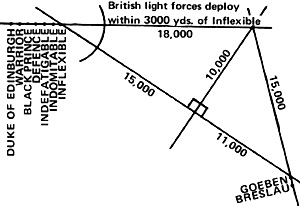 |
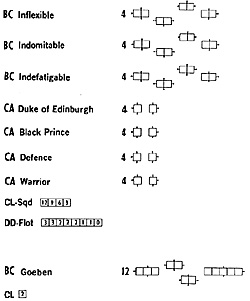
|
Back to Conflict Number 1 Table of Contents
Back to Conflict List of Issues
Back to MagWeb Master Magazine List
© Copyright 1998 by Dana Lombardy
This article appears in MagWeb (Magazine Web) on the Internet World Wide Web.
Other military history articles and gaming articles are available at http://www.magweb.com